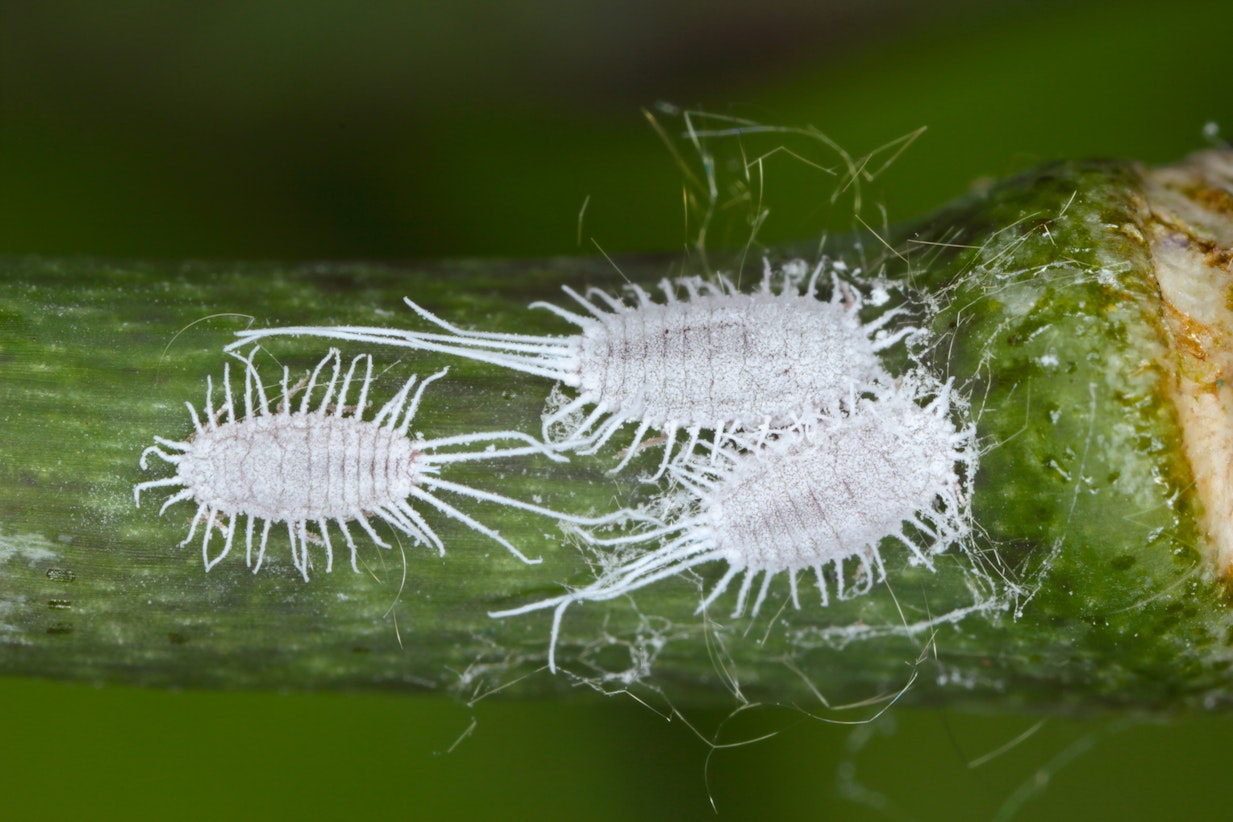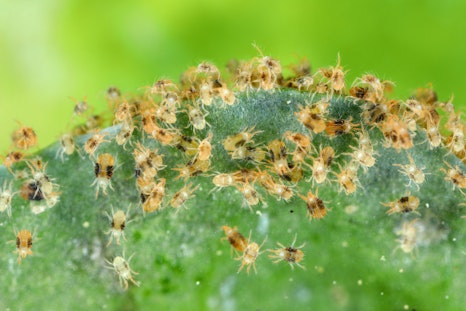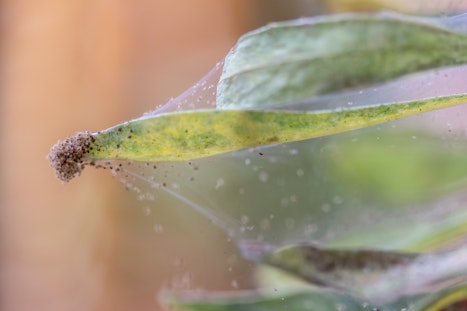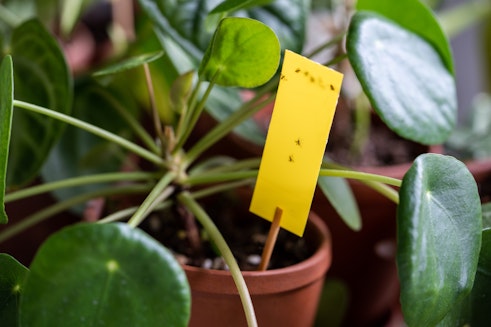
- Home
- Mealybugs - What are they and how do I get rid of them?

There is little worse than the horror of discovering little cotton-wool spots on the leaves of your plant. You close your eyes, cross your fingers and hope that maybe there can be some other explanation, but no. You have met the mealybug. He and his friends sit on the stem and petioles of your favourite plants, laughing as they chomp away without a care in the world. But fear no longer, for there is a solution. This post has everything you need to know to defeat this little villain, slow his spread and ensure he stays away from your plants!
First of all, it is important to note that the presence of pests says little to nothing about their keeper. Bringing plants into a house is like opening up a new, little ecosystem in your home. In the wild, these ecosystems contain all manner of beasts that keep each other in check and maintain a perfect balance, so that everything can thrive the way evolution intended. Unfortunately, in a home, the aspects of your ecosystem that are missing can be those which keep things like pests from getting out of control. As a result, we as plant-keepers must intervene. This is true for plant keeping at any level: from an orchid in the kitchen window, to an elaborate botanical garden greenhouse.
What is a mealybug?
A mealybug (Pseudococcidae) is a small, soft-bodied insect that feeds on the juices of plants. They attach themselves to the stem or petioles of a plant and secrete a white, waxy substance that shields them from the outside world while they eat. Of the 2000 or so species of mealybug described, the majority are considered pests and cause havoc in greenhouses and agricultural systems across the globe. A small infestation of mealybugs can be managed quite easily; however, a single mealybug can lay several hundred eggs at once, and a year can see two to three generations of them, so an infestation can very quickly get out of control if not seen to.
How do I know if I have mealybugs?
The symptoms to look out for are as follows:
- Look for wax: The first and most obvious clue to the presence of mealybugs is a light, fluffy wax substance around the crevices of your plant. This substance is usually white, but can be stained black by soot-mould.
- Look for bugs: Looking underneath the fluffy wax can sometimes reveal the insect itself, which is a round, white insect with six legs and antennae and feelers protruding from the front and back. Otherwise, clutches of small orange eggs can sometimes be seen too.
- Look for poorly plants: Sometimes, having plants with stunted growth, premature leaf-drop or misshapen leaves can be a sign of mealy-bugs.
- Check the roots: Mealybugs are not confined to the exposed parts of plants, and some can exist in the soil and feed on the root system, which will present as a white fluffy substance around the roots of a plant.
How do I get rid of mealybugs?
There are several solutions to remove mealybugs, depending on the severity of the infestation.
- Spray: For light infestations, mealybugs can be removed by force, with a spray of water from a pressurised bottle. This can physically remove them from the plant without the use of any chemicals or materials.
- Wipe: Similarly, wiping the stems, petioles and leaves of the infested plant with a wet cloth can physically remove them, and eliminates any possible tissue damage from the impact of a spray bottle.
- Prune: Sometimes, the infestation can be present only on one section of a plant, if possible, the removal of this section can eliminate the infestation entirely. Otherwise, the removal of any affected leaves can also stop the infestation. This is a good method for stronger plants that may only be affected on their soft, new growth.
- Dispose: For severe infestations that cannot be controlled, disposing of the affected plant can be the only solution. This ensures that the infestation cannot spread to other, nearby plants.
- Alcohol: A combination of 70% rubbing alcohol and water, applied to the body directly, dissolves the exoskeleton and ensures that the mealybug succumbs to the elements and dies. This is true also for mealybug eggs, and should be reapplied every few days until the infestation is gone.
- Insecticidal soap: Mixing a concentration of Insecticidal soap and water, and applying it to all parts of the plant with a spray bottle is a good method to ensure that the whole plant is treated. SB Invigorator is effective but requires 2 applications within 7 days; the first application will remove the waxy coat from any remaining mealybugs, the second application will kill them.
- Repotting: For root infestations, changing the soil and washing the roots with insecticidal soap can be a good solution to ensure that the mealybugs are not hiding in the soil.
- Horticultural oil: Applying neem oil can coat mealybugs and their eggs and suffocate them. The oil can be mixed with water and sprayed directly onto the plant, or poured into the soil for root infestations. These processes should be repeated every few days until the infestation goes away.
- Natural predators: Introducing natural predators can be an effective and long lasting way to control mealybug infestations. Predators can be found easily online and are best for greenhouse or outdoor environments. But for indoor environments, you can use ‘Mealybug destroyers’ (Cryptolaemus montrouziemi) or predatory Mites (Amblyseius), which prey on the mealybug and its eggs, without harming any plants.
The best way to ensure complete control over a mealybug infestation is to use a combination of the above techniques, and to regularly check all plants, and repeat processes until there has been no sign of mealybugs for at least a week.

How can I prevent them in the future?
The prevention of mealybugs is a useful factor in ensuring that infestations do not have to be tackled. Luckily, mealybugs are not prolific travellers, and are unlikely to infest your home unless brought in on something else.
There are several ways you can ensure that mealybugs stay away from your plants:
- Isolate infested plants: If an infestation is found, isolate the affected plant to ensure the infestation doesn’t spread to others.
- Check new plants: When purchasing a new plant, check it thoroughly for pests before bringing it home. Most mealybug infestations come from outside the home, and many are brought in on plants. Some people suggest isolating all new plants for several weeks, just to be sure there is no risk of infestation.
- Keep plants healthy: Your plants are actually pretty good at fending off bugs by themselves. If they are in any way compromised, then their immune system will be less able to assist them during an infestation. So, avoid over and under watering, root binding and make sure they have adequate light!
- Check vulnerable plants regularly: The sooner an infestation is tackled, the easier it will be! Most plants can be a victim of mealybug attacks, but specific plants to keep an eye on are: Ficus, Aroids (Monstera, Philodendron, Aglaonema, Epipremnum etc.), Cacti & Succulents, Hoya, Orchids, Ferns and Dracaena. These plants all have adequate hospitable space on their stems or bodies for mealybugs to attach themselves to. Be sure to check new growth, as its recent formation means the tissue is soft and easily punctured by the mealybug’s mouth. Resultantly, it is more susceptible to an infestation.
- Check tools & sundries: Mealybugs & their eggs can survive for brief periods on tools, and can be transferred unknowingly to plants through use. When using tools such as pruning scissors or trowels, ensure to wash them afterwards to ensure there are no unwanted hitch-hikers. When repotting plants, it is always a good idea to wash nursery pots or ceramics before or after use.
Remember that prevention is always the best solution, and can ensure you never have to deal with mealybugs in the future. However, if mealybugs do find their way onto your plants, don’t panic. Return to this guide at any time, try any of the above methods, and the mealybugs will regret the day they picked your plants to bother!
Jonathan Davies
Jonny has worked at Root since May 2023. His love for plants was inherited initially from his grandparents and parents, but really took off once he moved into his own place, where he started picking up small plants and was fascinated by watching how they grow and change over time. Jonny has a degree in Archaeology and Classics from the University of Sheffield, and a masters in Egyptology from Swansea University, where he primarily focused on garden culture in the ancient world, which he has managed to extend to a PhD thesis in the University of Liverpool, where he has been able to combine his love for plants with his love for ancient language and culture. Jonny loves being in the natural spaces around North Wales and Cheshire where he used to go growing up, and often spends hours examining the plants and trees, and kicking up the leaf litter searching for mushrooms and insects. He is fascinated most by plant biology, taxonomy and learning about ecosystems and interactions between plants and their environmental counterparts, and enjoys tending to his varied array of houseplants, and ongoing ‘plant projects’, such as growing plants from seeds and creating living epiphyte displays. Aside from his green thumb, his other interests include: art, reading, listening to and playing music in the company of his cats, Spooky and Boo.
More by Jonathan DaviesRelated Articles
View all articles



